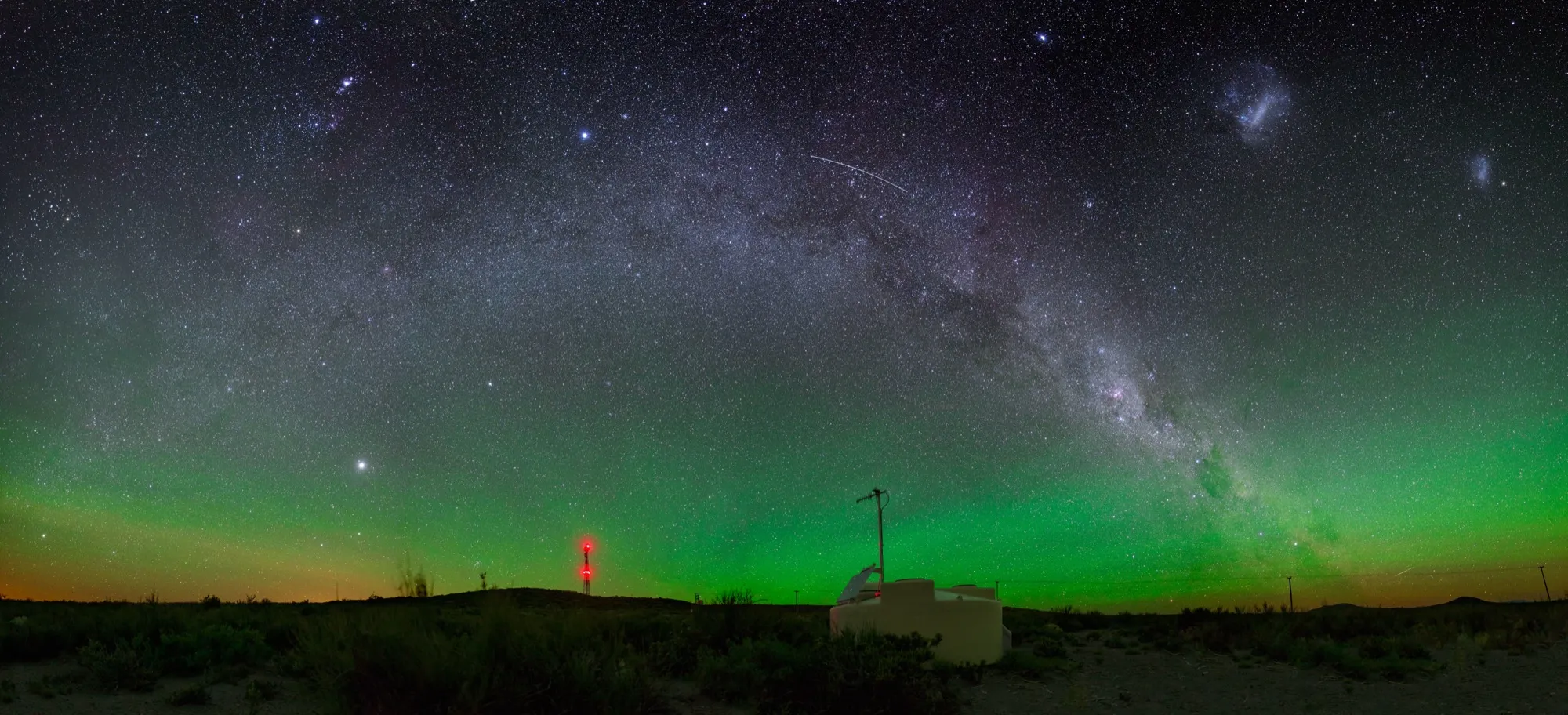



Unravelling the mystery of high-energy cosmic rays, the most energetic particles observed in nature. What are cosmic rays? Where do they come from? How do they get their energy?
Research Area
On the vast plain known as the Pampa Amarilla in western Argentina, the Pierre Auger Observatory is studying the highest-energy particles in the Universe, which hit the Earth from all directions, so-called cosmic rays. Cosmic rays with low to moderate energies are well understood, while those with extremely high energies remain highly mysterious. By detecting and studying these rare particles, the Pierre Auger Observatory is tackling the enigmas of their origin and existence.
The Auger Observatory is a “hybrid detector”, employing two independent methods to detect and study high-energy cosmic rays. One technique detects high energy particles through their interaction with water placed in surface detector tanks. The other technique tracks the development of air showers by observing ultraviolet light emitted high in the Earth’s atmosphere. The hybrid nature of the Pierre Auger Observatory provides for two independent ways to see cosmic rays.
The Astroparticle Physics group at IGFAE led by Prof. Enrique Zas has played a relevant role since its incorporation into the Auger Collaboration in 2002. Among the many contributions of this group, it is worth mentioning the search for ultra-high energy neutrinos and the analysis of inclined showers. Both works have allowed to the collaboration to achieve important science results as those two recently awarded as the Physics World Top Ten Breakthroughs of 2017.
The Astroparticle Physics group is composed of four senior members (Jaime Alvarez-Muñiz, Lorenzo Cazón, Gonzalo Parente and Enrique Zas) two postdoctoral researchers (Marvin Gottowik and Felix Riehn), and four PhD students (Juan Ammerman, Sergio Cabana, Yago Lema and Miguel Martins). The group participates in the Pierre Auger Observatory since 2002 when Spain became a full member of the Pierre Auger Collaboration consisting of more than 400 scientists from 20 countries.
Astropart. Phys.166(2025), 166, (2025)
JCAP
Albrecht, J. ... Riehn, F. et al.
All authors
Alameddine J.M., Albrecht J., Ammerman-Yebra J., Arrabito L., Alves A.A., Baack D., Coleman A., Dembinski H., Elsasser D., Engel R., Faure A., Ferrari A., Gaudu C., Glaser C., Gottowik M., Heck D., Huege T., Kampert K.H., Karastathis N., Nellen L., Pierog T., Prechelt R., Reininghaus M., Rhode W., Riehn F., Sackel M., Sampathkumar P., Sandrock A., Soedingrekso J., Ulrich R.
Phys. Rev. Lett. 134(2025), 134, (2025)
JCAP
Abreu, P. ... Alvarez-Muniz, J., Parente, G., Riehn, F., Zas, E. et al.
All authors
Abdul Halim A., Abreu P., Aglietta M., Allekotte I., Almeida Cheminant K., Almela A., Aloisio R., Alvarez-Muniz J., Ammerman Yebra J., Anastasi G.A., Anchordoqui L., Andrada B., Andringa S., Apollonio L., Aramo C., Araujo Ferreira P.R., Arnone E., Arteaga Velazquez J.C., Assis P., Avila G., Avocone E., Bakalova A., Barbato F., Bartz Mocellin A., Bellido J.A., Berat C., Bertaina M.E., Bhatta G., Bianciotto M., Biermann P.L., Binet V., Bismark K., Bister T., Biteau J., Blazek J., Bleve C., Blumer J., Bohacova M., Boncioli D., Bonifazi C., Bonneau Arbeletche L., Borodai N., Brack J., Brichetto Orchera P.G., Briechle F.L., Bueno A., Buitink S., Buscemi M., Busken M., Bwembya A., Caballero-Mora K.S., Cabana-Freire S., Caccianiga L., Campuzano F., Caracas I., Caruso R., Castellina A., Catalani F., Cataldi G., Cazon L., Cerda M., Cermenati A., Chinellato J.A., Chudoba J., Chytka L., Clay R.W., Cobos Cerutti A.C., Colalillo R., Coluccia M.R., Conceicao R., Condorelli A., Consolati G., Conte M., Convenga F., Correia Dos Santos D., Costa P.J., Covault C.E., Cristinziani M., Cruz Sanchez C.S., Dasso S., Daumiller K., Dawson B.R., De Almeida R.M., De Jesus J., De Jong S.J., De Mello Neto J.R.T., De Mitri I., De Oliveira J., De Oliveira Franco D., De Palma F., De Souza V., De Souza De Errico B.P., De Vito E., Del Popolo A., Deligny O., Denner N., Deval L., Di Matteo A., Dobre M., Dobrigkeit C., D'Olivo J.C., Domingues Mendes L.M., Dorosti Q., Dos Anjos J.C., Dos Anjos R.C., Ebr J., Ellwanger F., Emam M., Engel R., Epicoco I., Erdmann M., Etchegoyen A., Evoli C., Falcke H., Farrar G., Fauth A.C., Fazzini N., Feldbusch F., Fenu F., Fernandes A., Fick B., Figueira J.M., Filipcic A., Fitoussi T., Flaggs B., Fodran T., Fujii T., Fuster A., Galea C., Galelli C., Garcia B., Gaudu C., Gemmeke H., Gesualdi F., Gherghel-Lascu A., Ghia P.L., Giaccari U., Glombitza J., Gobbi F., Gollan F., Golup G., Gomez Berisso M., Gomez Vitale P.F., Gongora J.P., Gonzalez J.M., Gonzalez N., Gora D., Gorgi A., Gottowik M., Grubb T.D., Guarino F., Guedes G.P., Guido E., Gulzow L., Hahn S., Hamal P., Hampel M.R., Hansen P., Harari D., Harvey V.M., Haungs A., Hebbeker T., Hojvat C., Horandel J.R., Horvath P., Hrabovsky M., Huege T., Insolia A., Isar P.G., Janecek P., Jilek V., Johnsen J.A., Jurysek J., Kampert K.-H., Keilhauer B., Khakurdikar A., Kizakke Covilakam V.V., Klages H.O., Kleifges M., Knapp F., Kohler J., Kunka N., Lago B.L., Langner N., Leigui De Oliveira M.A., Lema-Capeans Y., Letessier-Selvon A., Lhenry-Yvon I., Lopes L., Lu L., Luce Q., Lundquist J.P., Machado Payeras A., Majercakova M., Mandat D., Manning B.C., Mantsch P., Mariani F.M., Mariazzi A.G., Maris I.C., Marsella G., Martello D., Martinelli S., Martinez Bravo O., Martins M.A., Mastrodicasa M., Mathes H.-J., Matthews J., Matthiae G., Mayotte E., Mayotte S., Mazur P.O., Medina-Tanco G., Meinert J., Melo D., Menshikov A., Merx C., Michal S., Micheletti M.I., Miramonti L., Mollerach S., Montanet F., Morejon L., Morello C., Mulrey K., Mussa R., Namasaka W.M., Negi S., Nellen L., Nguyen K., Nicora G., Niechciol M., Nitz D., Nosek D., Novotny V., NoZka L., Nucita A., Nunez L.A., Oliveira C., Palatka M., Pallotta J., Panja S., Parente G., Paulsen T., Pawlowsky J., Pech M., Pekala J., Pelayo R., Pereira L.A.S., Pereira Martins E.E., Perez Armand J., Perez Bertolli C., Perrone L., Petrera S., Petrucci C., Pierog T., Pimenta M., Platino M., Pont B., Pothast M., Pourmohammad Shahvar M., Privitera P., Prouza M., Querchfeld S., Rautenberg J., Ravignani D., Reginatto Akim J.V., Reininghaus M., Ridky J., Riehn F., Risse M., Rizi V., Rodrigues De Carvalho W., Rodriguez E., Rodriguez Rojo J., Roncoroni M.J., Rossoni S., Roth M., Roulet E., Rovero A.C., Ruehl P., Saftoiu A., Saharan M., Salamida F., Salazar H., Salina G., Sanabria Gomez J.D., Sanchez F., Santos E.M., Santos E., Sarazin F., Sarmento R., Sato R., Savina P., Schafer C.M., Scherini V., Schieler H., Schimassek M., Schimp M., Schmidt D., Scholten O., Schoorlemmer H., Schovanek P., Schroder F.G., Schulte J., Schulz T., Sciutto S.J., Scornavacche M., Sedoski A., Segreto A., Sehgal S., Shivashankara S.U., Sigl G., Silli G., Sima O., Simkova K., Simon F., Smau R., Smida R., Sommers P., Soriano J.F., Squartini R., Stadelmaier M., Stanic S., Stasielak J., Stassi P., Strahnz S., Straub M., Suomijarvi T., Supanitsky A.D., Svozilikova Z., Szadkowski Z., Tairli F., Tapia A., Taricco C., Timmermans C., Tkachenko O., Tobiska P., Todero Peixoto C.J., Tome B., Torres Z., Travaini A., Travnicek P., Trimarelli C., Tueros M., Unger M., Vaclavek L., Vacula M., Valdes Galicia J.F., Valore L., Varela E., Vasquez-Ramirez A., Veberic D., Ventura C., Vergara Quispe I.D., Verzi V., Vicha J., Vink J., Vorobiov S., Watanabe C., Watson A.A., Weindl A., Wiencke L., Wilczynski H., Wittkowski D., Wundheiler B., Yue B., Yushkov A., Zapparrata O., Zas E., Zavrtanik D., Zavrtanik M., Prechelt R., Romero-Wolf A., Wissel S., Zeolla A.
All authors
Cazon L., Conceicao R., Martins M.A., Riehn F.
Principal investigator
Lorenzo Cazón Boado
Initial date
2025-04-01
Final date
2027-03-31
Principal investigator
Enrique Zas Arregui
Initial date
2024-09-01
Final date
2028-08-31
Principal investigator
Lorenzo Cazón Boado
Initial date
2024-06-03
Final date
2025-06-07
Principal investigator
Jaime Álvarez Muñiz
Initial date
2023-09-01
Final date
2026-08-31
Principal investigator
Jaime Álvarez Muñiz
Initial date
2023-09-01
Final date
2026-08-31
Agency
AEI - Agencia Estatal de Investigación